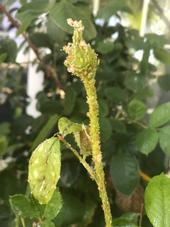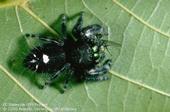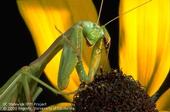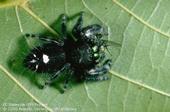- Author: Elaine Lander
- Author: Karey Windbiel-Rojas

“Aphids are really bad this year!” This is what we've been hearing on social media and from many home gardeners. Aphids can curl leaves, stunt plant growth, and make a mess by the sticky honeydew they exude. Some aphid species create galls which can also damage plants. Low to moderate aphid infestations usually don't damage plants but if you do have more aphids this year, there are many options for controlling them.
Aphids in landscapes and gardens can be managed by a number of different methods, including biological control. Biological control is when naturally occurring beneficial insects, mites, or other organisms (also called natural enemies) reduce a pest's abundance by eating or parasitizing them.
There...
- Author: Elaine Lander

While you are home working, learning, or relaxing, you may have noticed a few other critters sharing space with you. If some of these critters have 8 legs, we have a video to show you how to catch and release them!
Why might you release spiders outside? Spiders are beneficial insects called natural enemies. They are predators that help control other pests and insect eggs.

Praying mantids are well-known predators we often see lurking around gardens, landscapes, and sometimes near porch lights, waiting for a tasty meal to arrive.
Praying mantid adults are 2 to 4 inches (5-10 cm) long and are usually yellowish, green, or brown. Mantids (often referred to as praying mantis) go through incomplete metamorphosis (egg, nymph, adult) and have one generation per year. Overwintering eggs are laid in groups in hard, grayish egg cases which are glued to wood, bark, or other plant material. Adults and immatures (nymphs) have an elongated thorax and grasping forelegs, which they have the...
![Green lacewing life cycle.[J.K. Clark]](https://ucanr.edu/blogs/UCIPMurbanpests/blogfiles/43911small.png)
Last week, we discussed some common beneficial predators that help control pests on garden and landscape plants. One such predator you might find, is a lacewing. In fact, you may have seen adult lacewings on or near porchlights in the evening, since these insects are attracted to lights.
Green Lacewings
Green lacewing (Chrysopa spp., Chrysoperla spp.) adults are green, soft-bodied insects with golden eyes and four membranous wings. Their larvae are pale with dark markings and a tapered tail, and measure 1/8 to 4/5 of an inch long.
There are several species of green lacewings; some species have predaceous adults, while others feed only on...

Thanksgiving is a time to gather together with family and friends. The occasion is usually centered around a big meal followed by pumpkin pie, and hopefully some time to let each person share a list of what they are most grateful for that year.
Here at UC IPM, we are adding beneficial insects to our “thankful” list! These helpful invertebrates (also called natural enemies) are often overlooked for the contribution they make to gardens and landscapes.
Natural enemies, such as spiders and certain mites and insects, can help reduce the number of pests in your garden. It's possible that part of the reason they are overlooked is because...


